#nemoralia
Explore tagged Tumblr posts
Text
Happy Nemoralia to all who celebrate!

#nemoralia#diana deity#diana devotee#roman paganism#roman polytheism#pagan#paganism#witchblr#witchcraft#witches of tumblr#paganblr
46 notes
·
View notes
Text

Now is the time to prepare your home and body for the Nemoralia (August 13th - 15th), the Festival of Torches. How will you honor Her?
Sweet Mother Hekáte, I thank You for the blessings You have bestowed upon me this day. I thank You for helping us in such a tough situation. I love You and am devoted to You, Goddess of All.
#hecate#pagan#devotion#goddess#heal me#healing#gratitude#thankful#paganblr#witchblr#nemoralia#hekáte#hekate#witch#witches#pagan witch#witchcraft#ækátî#ekáth
31 notes
·
View notes
Text
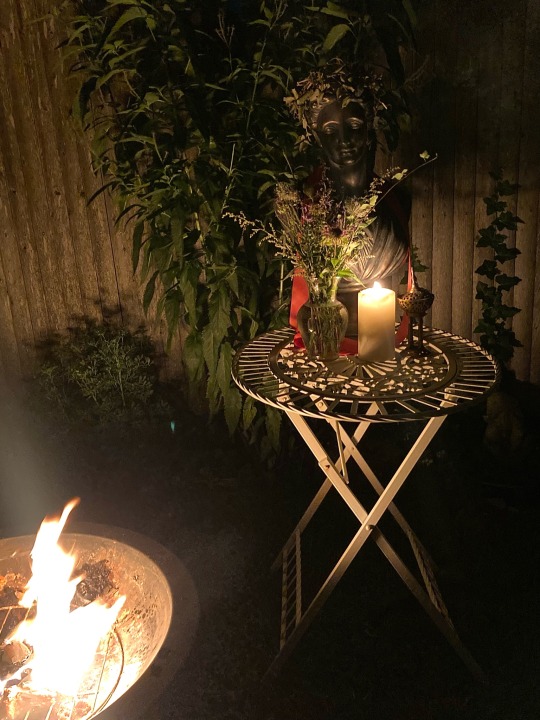

Another lovely Nemoralia; the first time I've celebrated on a blue moon. Clearly I'm a little behind on my posting.
It was lovely to see so many people spending time with the moon that night in their own personal ways.
🌕
🦌
🔥
#Nemoralia#diana#polytheism#August#ritual#Roman#Roman polytheism#ancient religion#religion#moon#magic
28 notes
·
View notes
Text
Of the moon 🏹✨
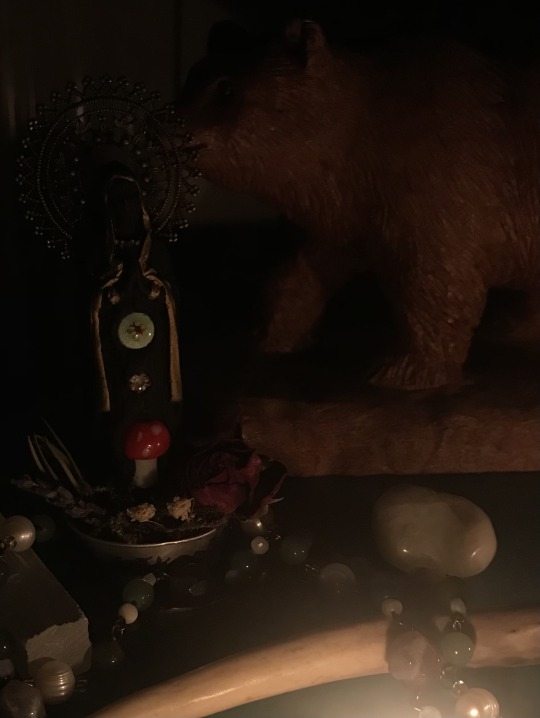
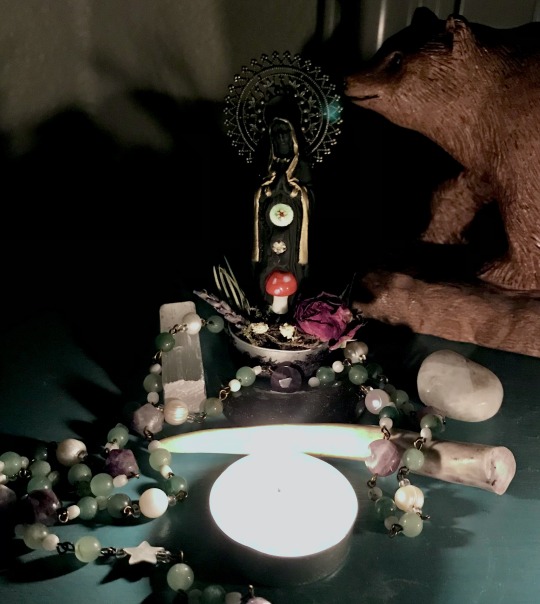
#diana🌙#Nemoralia#not able to have a more elaborate nemoralia offering and altar but quality time with my goddess and prayer is still nice#Goddess Diana#my posts#my pictures#Diana Abnoba#I love my statue for her so much
9 notes
·
View notes
Text
so beautiful! 🥹🌸



Had the chance to see the stunning 'Diana on the Stag' (1610) by Paulus Attinger ✨️
#all-things-artistic::🎨#silly-sybil-reblogs#cultus-deorum::🪔#all-things-pagan::🌿#goddess diana#diana#ancient roman religion#roman polytheist#roman pantheon#roman polytheism#nemoralia#roman paganism#cultus deorum#religio romana
114 notes
·
View notes
Text
Hellenic Gods Fact Sheets and Hymns: Hecate
Other Names: Trivia, Brimo
Epithets: Anassa eneroi (queen of those below), Aidonaia (lady of the Underworld), Amibousa (she who changes), Atalus (tender, delicate), Borborophorba (she who feeds on filth), Brimo (angry, terrifying), Despoina (mistress), Eileithyia (of childbirth), Enodia (of the roads), Epaine (dread), Euplokamos (bright-tressed), Khthonia (of the Underworld), Kleidouchos (keeper of the keys), Kourotrophos (protector of children), Krokopelos (saffron-robed), Liparokredemnos (bright-coiffed), Nycteria (nocturnal; of the night), Nyctipolos (night-wandering), Perseis (destroyer/ daughter of Perses), Phosphoros (light bearer), Propolos (guide), Propylaia (the one before the gate), Scylacagetis (leader of dogs), Soteira (savior), Trikephalos (three-headed/of the crossroads), Trimorphos (three-formed), Trioditis (of the three ways), Trivia (of the three ways).
Domains: Witchcraft, magic, necromancy, ghosts, nightmares, death, initiation, the crossroads, gateways, passage between worlds, and the night.
Appearance: [My UPG] A tall (over 6’) woman, neither young nor old, with waist-length black hair, pale skin, prominent cheekbones, a heavy jaw, and intense green eyes. She is usually dressed in black folds molded into a simple dress or robes. She has a severe expression and an intimidating presence. She speaks with a low voice.
Sacred Days and Festivals: Eleusinia (22 Metageitnion). Nemoralia (August 13th-15th). Deipnon, last day of each (lunar) month.
Symbols/Attributes: Torches, keys, daggers, strophalos (iynx wheel)
Sacred Animals: Dog, polecat, serpent, horse, frog.
Sacred Plants: Yew, cypress, garlic, willow, hazel, black poplar, aconite, belladonna, dittany, mandrake, hemlock, asphodel
Elemental Affinity: Darkness, light, fire
Planet: Moon
Colors: Black, saffron, silver.
Crystals: Black onyx, hematite, obsidian, black tourmaline, moonstone, smoky quartz, agate, amethyst.
Incense: Myrrh, almond, cypress, camphor, saffron, mugwort, pomegranate.
Tarot Cards: The High Priestess, The Moon, Death
Retinue: Empousai, ghosts of the dead, dogs, Lampades (torch-bearing underworld nymphs)
Associated People: Witches (and other magic-users), the dead
Offerings: Bread, eggs, honey, garlic, menstrual blood, graveyard dirt.
Syncretized With: Artemis, Diana, Persephone, Eileithyia, Selene, Nephthys, Ereshkigal, Nicnevin, Heqet
Hymns to Hecate
Orphic Hymn to Hecate
Hekate Enodia, Trivia, lovely dame, Of earthly, watery, and celestial frame, Sepulchral, in a saffron veil arrayed, Pleased with dark ghosts that wander through the shade; Daughter of Perses, solitary goddess, hail! The world’s key-bearer, never doomed to fail; In stags rejoicing, huntress, nightly seen, And drawn by bulls, unconquerable, monstrous queen; Leader, Nymphe, nurse, on mountains wandering, Hear the suppliants who with holy rites thy power revere, And to the herdsman with a favoring mind draw near.
Hecate’s Hymn to Herself
I come, a virgin of varied forms, wandering through the heavens, bull-faced, three-headed, ruthless, with golden arrows; chaste Phoebe bringing light to mortals, Eileithyia; bearing the three synthemata [sacred signs] of a triple nature. In the Aether I appear in fiery forms and in the air I sit in a silver chariot, Earth reins in my black brood of puppies.
(From Porphyry’s lost commentary on the Chaldean Oracles, preserved by Eusebius of Caesaria in Praeparatio Evangelica. According to Porphyry, this hymn was composed by Hecate herself.)
Magical Invocation to Hecate
Approach, you of the netherworld, of earth, of heaven, Bombo! You by the wayside, at the crossroads, light-bearer, night-wanderer, Enemy of light, friend and companion of night, Rejoicing in the howl of dogs and in crimson gore, Lurking among the corpses and the tombs of lifeless dust, Lusting for blood, bringing terror to mortals, Grim one, Ogress [Mormo], Moon – you of many forms, May you come gracious to our sacrificial rites!
(Preserved in Refutation to All Heresies by Hippolytus)
Invocation to Hecate from PGM IV 2708-84
Come, giant Hecate, Dione’s guard, O Persia [daughter of Perses], Baubo Phroune, dart-shooter, Unconquered Lydian, the one untamed, Sired nobly, torch-bearing, guide, who bends down Proud necks, Kore, hear, you who’ve parted / gates Of steel unbreakable. O Artemis, Who, too, were once protectress, mighty one, Mistress, who burst forth from the earth, dog-leader, All-tamer, crossroad goddess, triple-headed, Bringer of light, august / virgin, I call you Fawn-slayer, crafty, O infernal one, And many-formed. Come, Hekate, goddess Of three ways, who with your fire-breathing phantoms Have been allotted dreaded roads and harsh / Enchantments, Hekate I call you
[…]
O Hekate of many names, O Virgin, Kore, Goddess, come, I ask, O guard and shelter of the threshing floor Persephone, O triple-headed goddess, Who walk on fire, cow-eyed BOUORPHORBE PANPHORBA PHORBARA AKITOPHI ERESHKIGAL / NEBOUTOSOUALETH Beside the doors, PYPYLEDEDEZO And gate-breaker; Come Hekate, of firey Counsel, I call you to my sacred chants.
#hecate#hekate#greek gods#greek goddess#hellenic paganism#hellenic polytheism#helpol#witchcraft#witchblr#hecate worship#fact sheets#orphic hymns#greek magical papyri
413 notes
·
View notes
Text
Nemoralia and the birthday of Goddess Diana

As I wasn't able to celebrate Nemoralia two days ago, I thought I'd make a post about it today. Nemoralia was a festival in honour of Goddess Diana. This festival was originally held at Diana's temple in Aricia, current day Nemi (50 minutes away from Rome by car).
May this informational post honor the goddess and help those that want to celebrate this festival.
August 13 - Diana's Dies Natalis
This was thought to be Diana's dies natalis (birthday) by members of the collegium of Diana and Antinous in Lanuvium.
Everyone took part in this festival though the main focus were women. As told by Plutarch, on this day, for reasons unknown nowadays, they washed their hair in a special ritual.
Enslaved people got this day off as they were under the protection of the goddess (worth to keep in mind that Diana's priest at Lake Nemi was always a runaway enslaved man). Male citizens and masters were able to participate in this festival but they were required to be on equal terms with women and enslaved people.
As this is one of the hottest days of the year, the celebrations started at night. Worshipers adorned not only their heads with flowers crowns, but also the heads of their dogs as they also took part in the celebration. Hunting or killing animals in any way was forbidden on this day. Horses were forbidden from entering this area.
At night, worshipers assembled at the Sanctuary and walked in a procession around Lake Nemi while holding candles or torches, similar to the ones Vestal Virgins carried. People wrote petitions on ribbons and tied them on tree branches and they also left votive offerings at the temple, especially related to part of the body in need of healing.
How to celebrate in current day
Make an offering to Diana. Some ideas are baking moon-shaped cakes, pouring wine, cutting a flock of your hair for her or lighting a special candle. You could also read a hymn in her honour.
Wash your hair or go to the hair salon to get a trim. Adorn it with flower crowns.
If you have a dog, pamper them!! Wash them, take them on a longer walk than usual, buy then special treats... The possibilities are endless.
Write your petitions in a ribbon and tie it in a tree branch. If you don't have any trees near you could also tie it to any plants you're growing at home or bury it in the ground.
Donate to good causes, foundations or shelters related to women, animals or those in need. The world really needs that right now.
If you are near Nemi, go to the ruins of the goddess' temple. People still give her flowers til this day. Also the council of Nemi celebrates Nemoralia since 2016, though I think this year was discontinued since I wasn't able to find any information about it.
The program is formed by different types of activities, from history or art lectures to guided tours or nature walks.


What's the actual date of Nemoralia?
There's a lot of confusion online about what the actual date of Nemoralia is, with some people saying it's only celebrated on the 13th, others saying it's on the 15th and others saying is a three day festival.
It's believed that at first it was celebrated on the full moon but during the Roman Republic it was set on August 13, as back then that's when the full moon happened. This has led modern scholars like Frazer to think that the festival may extended over a few days instead of just one.
So, when to celebrate? If you want to follow the Roman calendar, it should be on August 13. However, if you want to celebrate on a full moon like ancient worshipers would have, then it depends on the year (in 2024 it would be on August 19).
Additionally, since it's believed Nemoralia became the Assumption of Mary through syncretism with Catholicism, you may want to choose August 15 to celebrate, because if you live in a Catholic country or canton you'll most likely get a day off from work - which means more time to celebrate!
May Dea Diana bless you all!
#paganblr#paganism#witchblr#witchcraft#polytheism#polytheist#Diana#dea Diana#goddess diana#diana worship#diana devotee#roman polytheism#roman paganism#rompol#helpol
36 notes
·
View notes
Text
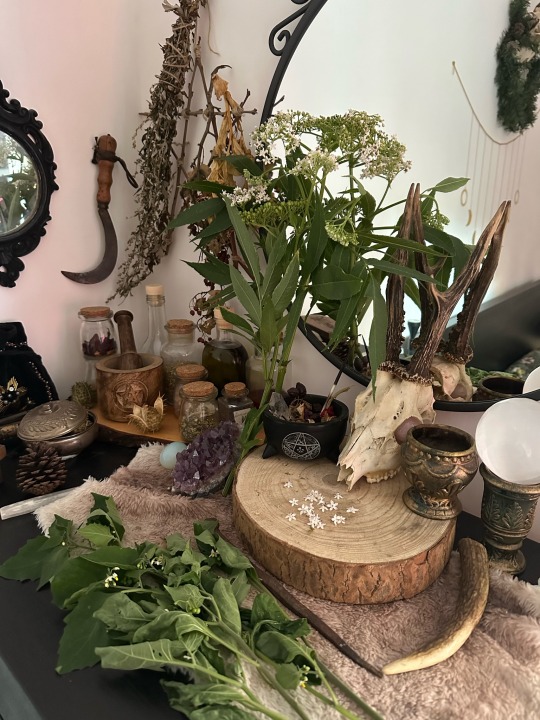
In Italy the 15th of August is a national holiday, Ferragosto, coming from the pagan festivity of “Feriae Augusti”, when Ottaviano Augusto was proclaimed emperor. Originally the whole month was a holiday, since there were also other festivities during that time (like the Nemoralia, 13th August, in honour of the goddess Diana).
Me and my boyfriend went to the woods to relax a bit and we decided to go a little farther than our usual places, here I stumbled upon glorious meadows full of beautiful plants 🍃💚
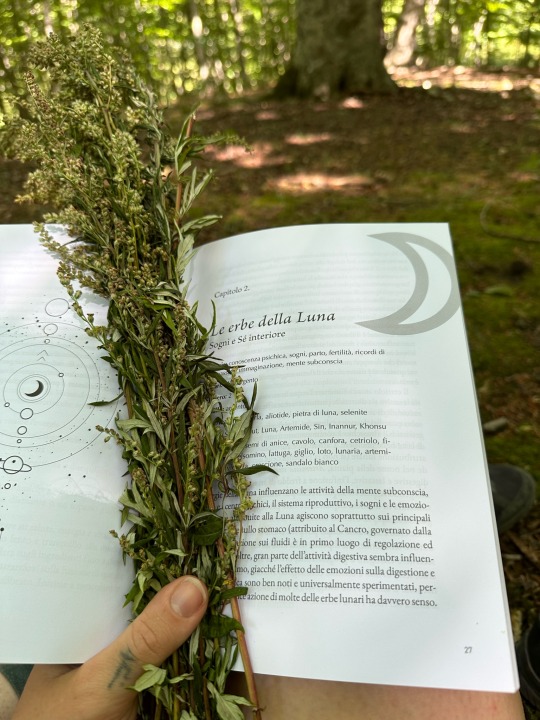
Artemisia vulgaris - my all time favourite ally, my Moon in plant disguise 🌙
~~~~~~~~~~

Solanum Nigrum - it was my first time meeting this plant and I’m very excited. That’s why I asked politely if I could take some branches with me and I felt like it was okay to. They’re now on my altar 🩶
~~~~~~~~~~~~~~~~~~

Datura Stramonium - my all time favourite, the one whom I feel so connected to. I’m about 6 feet tall and this one was taller than me! 🥀
~~~~~~~~~~~~~~~~

And dwarf elder flowers! They’re so cute (even cuter than ‘normal’ elder flowers) 🌸
#witch#witchcraft#pagan#nature#witchy#magic#personal#traditional witchcraft#magick#wicca#tradcraft#plants#occult#occult herbalism#herbalism#witchblr
272 notes
·
View notes
Text
This year, the Feast of Hecate, which we’ve adopted into our own craft, falls on the Dark Moon and the peak of the Perseid meteor shower. Several years ago, we published an article on Hecate and the origin of her festival on August 13. In the early 2000’s this festival was commonly ascribed to an aspect of Hecate known as the Lady of Storms with some notion that part of the reason for the festival was to propitiate Her to protect the harvest. Our work and experiences with Our Lady of Night have changed and evolved since that time, and as the feast date continues to grow in popularity, we thought we’d revisit the article.
Back in 2007 we wrote:
There’s not much in the classical literature about [Hecate] being associated with storms, beyond that Zeus ‘gave’ her power over all realms. Her dominion here instead seems to grow out of the “dark and stormy night” image that she developed during the middle ages. There is, however, widespread belief among modern worshipers that she has a feast day on August 13 to protect the crops from violent storms. Wikipedia is perpetuating this belief, citing Leo Ruickbie’s “Witchcraft out of the Shadows” (2004). In a side-box he claims that the ancient Greeks observed a feast day on August 13 in which Hecate was propitiated to not send storms to destroy the growing crops. Ruikbie, in turn, cites his source as Diane Stein’s “The Goddess Book of Days” (Llewellyn, 1997). Her original calendar was published in 1988 and does not give a primary source. Various Internet sites claim that this occurred in the House of Storms and Fertility, that it was a Festival to Hecate of the Moon, or that it was part of the Festival of Hecate and Artemis. Mikalson, in The Sacred and Civil Calendar of the Athenian Year lists for Metageitnion 16 that “the sacrifical calendar of the deme Erkhia prescribes sacrifices on this day to Kourotrophos and Artemis Hekate.” Metageitnion is the Attic lunar month that lines up with late July/August. The 16th would be two days after the full moon (July 31, this year). Unfortunately, I cannot find what occurred during the rite (if anything specific at all). Still, this doesn’t explain why August 13 was chosen, fixed as it is to the Roman solar year instead of the lunar calendar used by the ancient Greeks. Also, there is never any mention as to why Hecate would be called to protect crops (as opposed to children and mothers-to-be). According to Brumfield in his book The Attic festivals of Demeter and their Relation to the Agricultural Year (1976), during the time of the year we call August, the grain harvest had been completed and the grape harvest would not have begun until September. August was a lull in the agricultural year and nothing needed to be protected from violent storms. A few clues come to light when we stop looking for ancient Greek sources. In Rome, The Festival of Torches was held on August 13, called the Nemoralia. In it, woman would walk from the city of Rome carrying torches to a lake sacred to Diana where they would offer their petitions. There was a strong conflation between Artemis and Hecate in Greece, with Hecate taking on a number of Artemis’ roles. Diana and Hecate were also conflated some, but typically maintained separate spheres of influence. Still, this seems to be a likely source for fixing the ritual on that particular date. Additionally, in 1986 a ritual performed on August 14, 1985, was published in Circle Network News which invoked Hecate Chthonia and incorporated a Hecate Supper. A web page by that author claims that a similar ritual incorporating much of the same text was performed at the MoonStone Circle of the Aquarian Tabernacle and published in Panegyria on August 13, 1988. The original date it was performed, August 14, 1985, was a dark moon, which has been a sacred time for Hecate since classical times. The other date, though, perhaps inspired by Stein’s recently published Goddess Book of Days, was a waxing gibbous. None of this explains a connection with storms or harvests, however. This strikes me as a purely Neopagan phenomenon rising out of widespread observance of harvest-type rituals during early August, the most common being the Celtic feast of Lughnasadh.
Eight years later, we still suspect the modern Feast of Hecate held on August 13 comes from the Nemoralia, the festival of Diana held in the groves at Nemi. This cult has a long association with modern paganism, being the inspiration and central study in Sir James Frazer’s The Golden Bough which, in turn, formed a pillar of the neo-pagan movement.
The goddess Diana as she was worshiped in the groves as Nemi possessed a triple form, not unlike the triform figure of Hekate that is familiar to many modern witches. One of the three was known classically as Hecate or Proserpina, something which has troubled me. Why is a Latin Goddess being called by the name of a different Greek goddess? Is it syncretism, like the conflation of Artemis and Hecate, and Artemis and Diana. CMC Green in Roman Religion and the Cult of Diana at Aricia offers this plausible explanation: “The identification of Diana with Hecate (a Greek name) has been made unnecessarily complicated. Diana the Huntress was identified with the moon, as Apollo was with the sun. As the moon grows dark once a month it is inevitable that a moon-goddess will have some part of her identity located in the underworld. Hecate is simply the Greek name for that part of her identity.” The names Hecate and Proserpina were also likely considered safe substitutes for the true name of the Underworld Moon.
There are numerous classical references to this association. One of Horace’s Odes mentions Diva Triformis, and Virgils Dido calls on “tergeminanque hecaten, tria virginis ora Dianae.” Isodore of Seville writing in the first century explains: “Concerning which Virgil writes..the three faces of the virgin Diana, because the same goddess is called Luna, Diana, and Proserpina��. This tripartate Diana persisted through the centuries, showing up in triple form in Chaucer’s Canterbury Tales and John Skelton’s Garland of Laurels in 1523 (“Diana in the leaves green, Luna that so bright doth sheen, Persephone in hell”). As mentioned previously, her cult instigated James Frazer’s life work The Golden Bough and influenced Robert Graves’ The White Goddess, through which the concept of the triple goddess was introduced to modern Wicca.
To return to the August festival which honored the three-fold goddess, Green’s translation of one of the poems composed by the Latin poet Statius in the 1st century CE is appropriate:
It is the season when the most scorching region of the heavens takes over the land and the keen dog-star Sirius, so often struck by Hyperion’s sun, burns the gasping fields. Now is the day when Trivia’s Arician grove, convenient for fugitive kings, grows smoky, and the lake, having guilty knowledge of Hyppolytus, glitters with the reflection of the multitude of torches; Diana herself garlands the deserving hunting dogs and polishes the arrowheads and allows the wild animals to go in safety, and at virtuous hearths all Italy celebrates the Hecatean Ides.
Finally, Green (really, just go pick up her book) suggests that the festival lasted 3 days, starting with her decent to the underworld on the Ides (August 13th) where she would be known as Hecate, and culminating on the 15th of August when she ascended as the Queen of Heaven, the full moon. Incidentally the 15th is celebrated as the Feast of the Assumption of Mary, Queen of Heaven, in the Christian church, who may have adopted this (non-infernal) part of the festival.
Today, the August 13 Feast of Hecate has grown immensely in popularity among modern pagans, and includes many individual observances as well as larger public rites such as Hecate’s Feast hosted by the Temple of Witchcraft. We conclude that the Hecate honored at these rites isn’t necessarily the Greek goddess of boundaries or Lady of Storms, but they are an indirect continuation of rites to the dread face of Diva Triformis as goddess of night, the queen of the dark moon roaming the underworld. This year, in addition to feasting on delicious Mediterranean food and wine, we’ll celebrate by giving offerings at the crossroads under the shower of falling stars and ritually blending an offertory incense for use in the coming year, Hecate the Saffron Clad. From the classical torch-lit rites within the grove at Nemi to modern observances by pagans and witches, August 13 brings together all those who form the conclave of the goddess of night. May she bless you all.
10 notes
·
View notes
Text
A picture of my altar for Artemis/Diana.

I pray to her during Nemoralia, when I cast nature spells.
4 notes
·
View notes
Text
Anonymous said:
Hi Spade… found this interesting… “Diana, or Artemis in Greek, is sometimes called a lesbian goddess because of her love for woman and her vow never to marry a man. The ancient Roman Festival of Torches (Nemoralia) was held from Aug. 13-15 as Diana’s chief festival. According to mythology, Diana preferred the company of women and surrounded herself with female companions. They took an oath of virginity and lived as a group in the woods, where they hunted and danced together.”
LINK

15 notes
·
View notes
Text
August 13th was the Feast of Hecate or as some call it, the Festival of Hecate. I didn't post about it because I wanted to do a bit of research first as I had thought the Night of Hecate was November 16th.
It turns out both are correct.
Feast of Hecate / Festival of Hecate is August 13th.
Night of Hecate / Hecate's Night is November 16th.
Who or what is Hecate? In Greek mythology Hecate is the Goddess of magick and witchcraft. In modern Neo Paganism she is represented as the Three-in-one, the one-who-is-three. This is The Maiden, Mother, and Crone (sometimes swapped out with "Queen" to be more polite). The Maiden, Mother, and Crone / Queen represent the different aspects of the eternal feminine, the nature of womanhood and the symbolism of the phases of the moon.
There is no historic basis for Hecate's Night being November 16th other than Neo Pagans wanted an autumn day to celebrate the Triple Goddess.
The August 13th version is interesting. Apparently it dates back to Ancient Rome where it was called The Nemoralia or the Hecatean Ides. It was celebrated for three days and arguably may have been more for Diana than Hecate.
Both the three day festival in August and the November 16th Night are acceptable times to celebrate Hecate even though the November version was a modern invention.
Here is a clip from The Sandman Netflix series episode 2 where Morpheus Summons Hecate, who is also the Fates and the Furies in The Sandman.
youtube
3 notes
·
View notes
Text
Diana: The Moon Goddess
Important in many aspects of Wicca, Diana is typically recognized widely throughout the community as the Moon Goddess.

Origins:
Seeming to originate in Roman mythos, Diana is Goddess of wild animals and the hunt (identified with the Greek goddess Artemis). In the beginnings of her story, Diana likely had no connection with the moon. However, it is popularly theorized that she later became associated through her connection to Artemis’s identification with both Selene (Luna) and Hecate. My personal theory on this matter is that Diana became affiliated with the moon through her status as a goddess of fertility and protector of women during labor, as the menstrual cycle is commonly seen to be similar to the cycle of the moon.
In her cult, Diana was also considered the protector of the lower classes, especially slaves. As I will mention later in the post, the 13th of August, her festival at Rome, was a holiday for slaves. A unique custom within those believing in Diana dictated that priests be a runaway slave and that they fell their predecessor in combat.
The most widely known place of worship for the Goddess was the grove of Diana Nemorensis (“Diana of the Wood”) on the shores of Lake Nemi at Aricia (modern Ariccia) near Rome. Associated with Diana were Egeria, the spirit of a nearby stream who shared with Diana the guardianship of childbirth, and the hero Virbius (the Roman counterpart of Hippolytus) who was said to have been the first priest of Diana’s cult at Aricia. As a recognized fertility deity, Diana was invoked by women to aid in conception and delivery. In found Roman art, Diana typically appears as a huntress with a bow and quiver. She was also usually seen accompanied by a hound or deer.

Triple Goddess Belief:
Seen with Luna and Hecate, it is believed that Diana is the Triple Goddess by some Wiccans. Some believe that instead of being part of a trifecta, the three statuses of the Triple Goddess are all Diana (representing the huntress, moon, and underworld).
How To Honor:
Diana is a goddess of nature, so honoring nature is honoring her. She is also, of course, the goddess of the moon. In this sense, honoring the moon and incorporating moon magic into your practice is also seen as a valid way of worshipping Diana.
Some today also continue the tradition of celebrating Nemoralia. Also known as the Festival of Torches, this is a three day festival originally celebrated by the ancient Romans on the Ides of August (August 13–15) in honor of the goddess Diana. Though it was originally celebrated at the Sanctuary of Diana at Lake Nemi, it soon became more widely celebrated. It is interesting to note that the Catholic Church may have adapted the Nemoralia as the Feast of the Assumption.
#lunar magic#moon magic#wicca#witch#witchy#diana#moon#roman goddess#roman mythology#mythology#mythos#myths#culture#religion#history
30 notes
·
View notes
Note
✴.·´¯·.·★🎀𝔀𝓱𝓮𝓷 𝔂𝓸𝓾 𝓰𝓮𝓽 𝓽𝓱𝓲𝓼, 𝓵𝓲𝓼𝓽 𝓯𝓲𝓿𝓮 𝓼𝓸𝓷𝓰𝓼 𝔂𝓸𝓾 𝓵𝓲𝓴𝓮 𝓽𝓸 𝓵𝓲𝓼𝓽𝓮𝓷 𝓽𝓸, 𝓽𝓱𝓮𝓷 𝓼𝓮𝓷𝓭 𝓲𝓽 𝓽𝓸 𝓽𝓮𝓷 𝓸𝓯 𝔂𝓸𝓾𝓻 𝓯𝓪𝓿𝓸𝓻𝓲𝓽𝓮 𝓯𝓸𝓵𝓵𝓸𝔀𝓮𝓻𝓼 (𝓹𝓸𝓼𝓲𝓽𝓲𝓿𝓲𝓽𝔂 𝓲𝓼 𝓬𝓸𝓸𝓵)🎀★·.·¯´·.✴
Well hello mada my fellow twoob enthusiast 🩷 thank you sweet thing 🫶🏻
2 notes
·
View notes
Text
Disclaimer: I would like to start this post by saying that I do not live in Nemi. That means that 1) I cannot provide the same amount of geographical or folkloric detailed knowledge a nemese would and 2) I am not providing any personal information. Secondly, I have used Italian resources only - more specifically, those I've found on the official website of the Comune [= town, Italian] of Nemi, among the many - as there are way more resources in my native language. I will, so, provide both Italian and translated versions of names and the like. Lastly, I want to specify that I have already posted this blog elsewhere: I will not be changing anything if not mistakes I might run into while re-reading it.
This being said, enjoy!

Nemi: the city of Diana
Introduction
I can't really use the same introduction I had used when I had first written this blog. This is for two reasons: first off, I had it written for a weekly challenge on an online community; secondly, my views and beliefs have profoundly changed ever since. When I had typed the first few words, I thought I belonged with the Celtic gods. Now, after a long time of consideration, I know I belong with the Roman ones. I like to think of this post as the first step that led me to choose Roman polytheism.
And now that you know the place that this post holds in my heart, you can also imagine why, of all posts, I have decided to repost this first.

Nemi
The myth of the foundation of Rome is very popular in Lazio, the twins Romulus and Remus being protagonists of said event and their mother being Rea/Rhea Silvia. The latter, is said to have been a priestess and/or devotee of Vesta, and this goddess' cult is said to have been one of the key elements of Nemi: that's the reason why some modern theories suggest that this town is where Rome first originated - perhaps, due to its closeness to the supposed location of Alba Longa, mythical hometown of Rhea Silvia.
Nemi is located in Lazio, a region of central-western Italy, and its territory is part of the Parco Regionale Suburbano dei Castelli Romani [= Regional Suburban Park of Castelli Romani, Italian]. Built over a lake of volcanic origin, this town is the smallest out of all of the ones in the Castelli Romani [= group of cities near Rome, whose history is closely tied to that of the capital]. In the pre-Roman era, the town was supposedly part of Aricia - a nearby Latin city - which, mythologically-talking, was founded by Theseus' son: Hippolytus. It is probably during this period that the temple of Diana Nemorensis was built, leading some historians to believe that Nemi is the place where the cult of this goddesss first started. The sanctuary reached its pitch of popularity with the Romans.
Furthermore, there used to be two ships, either commissioned by Tiberius or Caligula, possibly dedicated to Diana and destined to parties - a footnote is necessary: the most accredited theory suggests that the ships were indeed commissioned by Caligula, but they were dedicated to the Egyptian goddess Isis. Unfortunately, not only did these ships sink and it took two expeditions - one in the 15th century, that failed, and one in the first half of the 20th century, which was successful - to retrieve them, but they also caught fire little after in the museum that used to host them.
The name of the city itself seems to be tied to Diana: Nemi is in fact a derivative of the Latin word "nemus" [= wood, Latin]. Nemi's wood that was sacred to Diana, and it was attributed to her through the title of "nemus Dianae" [= wood of Diana, Latin]. Two more derivatives of the word "nemus", that seem to highlight the deep bond between the goddess and the town, are the epithet contained in "Diana Nemorensis" [= Diana of the wood] and the name of the festival of "Nemoralia" - a celebration that took place on the 15th of August to honour Diana herself.
This being said, the connection between Diana and Nemi is, to say the least, very explicit.
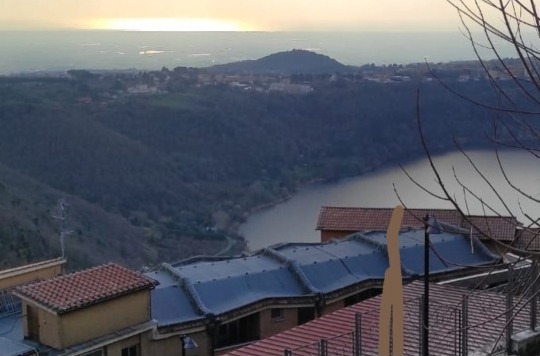
Il bosco - The wood
Contrarily to what the title might state, this paragraph will not be focusing on the wood itself. Rather, it'll focus on what used to happen in the wood. It is said that there was to be a man who used to merge mystery and legend, intertwining history and myths at the same time. I am talking about the figure of the rex nemorensis [= king of the wood]. Its existence finds a direct connection to that of the rex of Rome, whose main role was that of main administrator in the archaic Roman religion, and was later on replaced by the pontifex maximus. It is still unknown whether he is an historically certified figure or if he was - and is - simply a part of the local folklore. There is a legend, however, that explains how the rex nemorensis was "chosen". For this myth/ancient tradition seems to have no correspondences whatsoever in Roman or, more broadly, Greek theology/mythology, I advice reading this paragraph as if it was talking about a story and nothing more: I am unsure of its historical reliability myself, not to talk about the fact that the official cerimony is still unknown to us. I am nonetheless going to add this piece of lore as it is an interesting folk take on the cult of Diana.
In the sacred wood of Diana, it is told that there is a tree, probably an oak, that catches the eye; mistletoe - a plant sacred to Diana - growing all around it. In front of it, there always seemed to be a silhouette of a man, holding a branch in his hand. He's keeping his guard up, scanning the wood ready to battle the enemy that's about to come. He's both a priest and a king: he's the rex nemorensis. The "enemy" who's about to be introduced is a slave who managed to free himself from his status - what one would call, in Latin, a libertus - and whose job is that of taking the life of the current rex nemorensis with a stick of mistletoe. If he's successful, he'll be granted that same position. The new ruler-priest will have the responsibility to grant abundance to the wood, and so he must dedicate himself to its patroness: Diana herself. With this alliance ensured, the new rex nemorensis can now officially take the place of the former until the cycle doesn't repeat again.
This legend is supposed to explain how cycles always start and end, as well as how a ritual worked. The origins of this myth are unknown: since it does not seem to have classical origins - Greek, Roman or Italic, that is - , it could be a product of syncretism of local folklore and mythology. I think it is worth to mention that one of the storytellers had suggested the myth being a descendant of the Celtic culture, as the figure of the rex nemorensis reminded them about the knowledgeable druids. Even though I do think that Indoeuropean ancient religions have a common root, I don't share this view as historically talking there is no evidence of Celts and Romans interacting in Lazio so back in time - and by "back in time" I mean at the very foundation of the Italian capital.
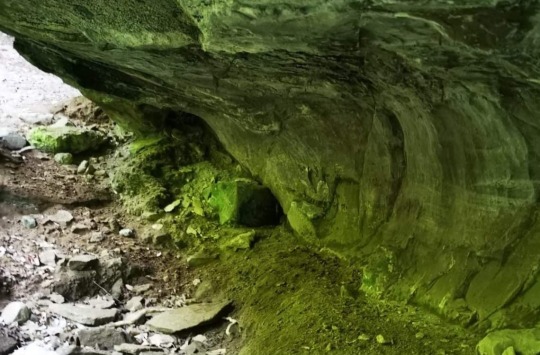
Lo "Specchio di Diana" - The "Mirror of Diana"
The "Specchio di Diana", or Lago di Nemi [= Lake of Nemi, Italian] is a lake of volcanic origin. Unfortunately enough, we do not have many records of legends and/or myths about this lake. Nor do we have, archeologically, much left of what used to be a place of great interest for pagan polytheists due to its connections to Diana. As I had already mentioned in the paragraph about Nemi, two ships were built here under commission - possibly - of Caligula. Later on, it is theorised that they might have been destroyed after the emperor passed away in order to remove every trace of him from the Roman culture.
But why is this place so connected to Diana? As far as we know today, it is mainly because of a legend: it is said that the goddess used to look at her reflection in the crystal clear waters of the lake. And that's probably a legend that became popular after the construction of the temple - which was built on the shore of the lake, even though the latter has now shrunk.
In modern times, the lake has become a destination of great interest to neopagans... almost as if the essence of the location never faded nor blurred.

Il santuario - The sanctuary
That is because this is the location where almost two millenia ago pagans used to reunite to celebrate Diana. The same sanctuary that basically gave birth to the city, literally leading to the construction of Nemi. This temple is, unfortunately, not open to visitors due to unspecified reasons - most probably, because of archeological excavations or restoration workings.
Historians have dated the construction of this great complex - we're talking about a 45.000 square metre surface, making this sanctuary one of the largest in Italy - back to the II-III century BCE circa. This temple was thought to be dedicated either to Diana or to Vesta due to an ambiguous inscription - the first piece to ever be retieved from the ruins. However, the most accredited theory reveals that this temple was indeed built in honor of the Roman goddess of the moon and hunt. The temple was visited by pagans until the 5th century - even though the its downfall started in the 2th century CE -, before Christianity took the place of polytheism. Still, it is said that some people kept visiting the sanctuary in secret, keeping on practicing the hypothetical "ritual" of the rex nemorensis - some state that this tradition survived through the early Middle Ages. And so did Diana, apparently, by becoming part of the local folklore under different figures - which is something I am going to discuss about later in this paragraph.
The "discovery" of the temple was a matter of luck: a marquis, whose surname was Frangipane, had bought that piece of land and decided to start archaeological excavations, bringing back to light part of the sacred building. We're in the XVII century, and further excavations protracted from late XVII century to late XVIII will eventually ruin what was left of the temple, almost completely erasing its existence: parts of what was once a sanctuary are now scattered all around the world, in different museums. We'll have to wait until the year 1924, when the Italian government decides to investigate further on the sacred area: this new operation will uncover the thermal baths and the theater that were part of the sanctuary, but they will be covered again little after.
Now, going back to how Diana possibly survived throughout all of these centuries. The first theory, is that some of her aspects were slowly transfered to Vergine Maria [= Virgin Mary, Italian]: two of them, being the serpent and the lunar horn. While Diana wears them on her head, the Madonna puts them under her foot - almost as a sign of the victory of Christianity over paganism. Another figure that might be a derivative of this goddess, is the Befana [= an old witch who brings sweets to kids on Epiphany in Italian folklore]. Both are tied with the legendary imagery of a woman flying on a broomstick - one carrying sweets; the other, Diana, bringing wealth and fertility to the land on the night between the 5th and the 6th of January.


Credits
Pardon me for the low quality of some of the images. I had to screenshot them from my previous post as I had no possibility of retrieving them elsewhere.
3D reconstruction of the temple from Nemora on Facebook.
GIF background found on Videvo.
The rest of the photos were sent to me by acquaintances and so shall not be used without permission.
#all-things-pagan::🌿#silly-sybil-informs#cultus-deorum::🪔#roman polytheism#roman paganism#diana#diana nemorensis#paganism#nemi#rex nemorensis#paganblr#witchblr#roman religion
11 notes
·
View notes
Text
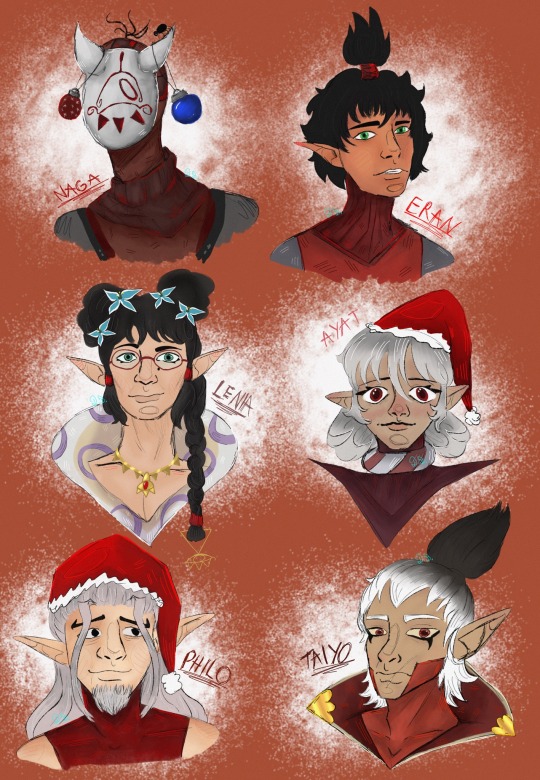
Also leaving this here A yiga oc doodle page as a Christmas gift. Happy Hollidays pals!!
Ok from top to bottom we got:
Naga - belongs to @lordsooga
Eran - belongs to @nemoralia
Lenia - belongs to @ / nightfrenzy on twitter
Ayat - belongs to @demongurrrl
Philo - belongs to @gspaepro
Tayio -belongs to @michwsstuff
#aughs hope you like them and hope I did them justice#<3333#yiga ocs#yiga clan#botw#yiga#botw oc#dragon’s art tag
24 notes
·
View notes